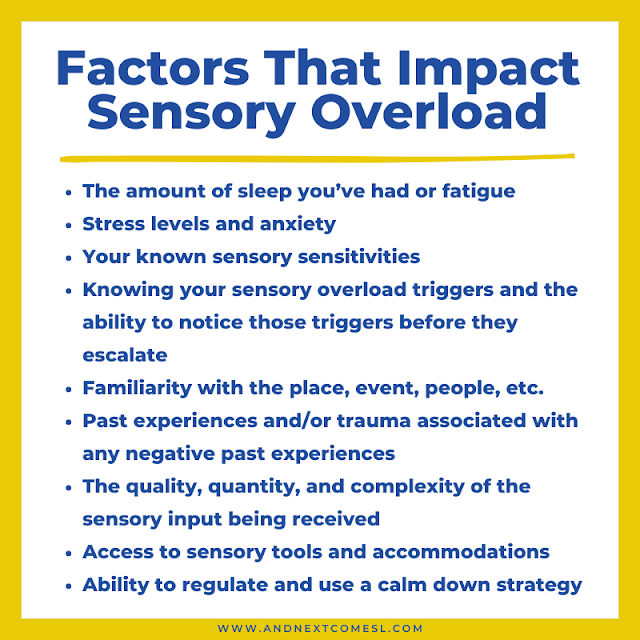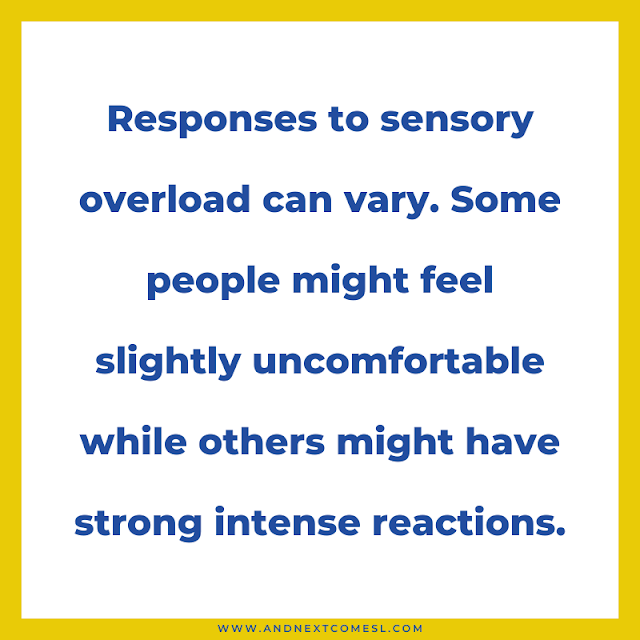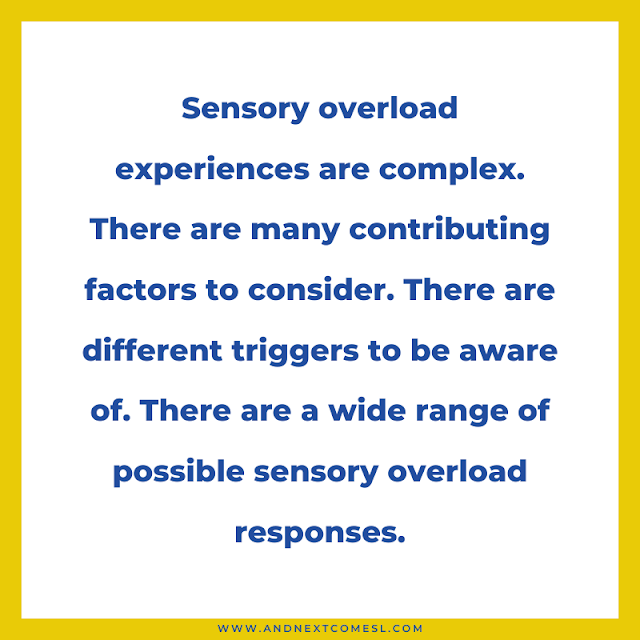There's a reason why your kid freaks out and covers their ears whenever they hear the noise of the hand dryers or the flush of the automatic toilets in a public washroom. I mean that's a lot of loud, complex sensory stimuli being received by the brain. And your kid just doesn't have the tools yet to adequately cope (although I do have a social story to help).
Those resulting meltdowns often come down to sensory overload and sensory issues though.
Everyone can experience sensory overload, both adults and children alike. You're not magically immune just because you're an adult. You just might have better tools in place to help you manage and cope with overwhelming sensory stimuli.
Like maybe the crowds, noise, and bright lights of shopping at Costco do you in (ahem...me). One way you might cope is by going when it's less busy and crowded.
However, for some, sensory overload is a much more frequent an common experience. In particular, for kids and those diagnosed with autism, hyperlexia, or sensory processing disorder, it can be an everyday occurrence. It can even occur multiple times per day.
Unfortunately, sensory overload is misunderstood by many.
Yet, sensory overload can often explain a lot of the "behavior issues" we see in kids or in autistic individuals. There's always such a big focus on the behavior. But many forget to zero in on what's actually triggering the behavior in the first place. More often than not, those "behavior issues" are actually sensory overload responses.
If you're new to understanding sensory processing, you might be wondering what is sensory overload exactly? And what triggers it? Well, let's take a closer look.
So...What is Sensory Overload Exactly? What Does it Mean?
Sensory overload happens when one or more of our senses becomes overstimulated and overwhelms our brain. There's simply too much incoming information for our brain to process properly.
With so many sensory inputs being received by the brain at once, it doesn't know which of these inputs to focus on or prioritize first. It's like it can't tell which is irrelevant sensory information and which is. So it struggles to filter out the unimportant sensory stimuli.
Then the brain tells your body that it needs to somehow get away from, block, or escape some of that sensory information. Which is why some of the more common sensory overload symptoms are to block out one source, shut down, and/or run. It makes sense if you think about it.
The body essentially responds with a flight, fight, or freeze response. It's as if your brain gets stuck. At least until you remove one or multiple sensory inputs. But removing some of that information and input isn't always easy. That's why it's sometimes just easier to run or cover your ears.
Some of the Most Common Sensory Overload Triggers (with Examples)
Since sensory overload can result from any of our senses (there are more than 5 senses, by the way!) being overwhelmed, what triggers one person might not trigger another. Everyone experiences things differently after all.
That means that different types of sensory stimuli can lead to sensory overload for different people. It might be the music, the flickering lights, the smell of someone's perfume, a crowded room...the list goes on and on. Everyone will have different triggers and tolerance levels.
But here are some of the more common examples of things that lead to frequent sensory overload:
- Public washrooms (those darn hand dryers and automatic flushing toilets are so loud!)
- Crowds or even tight spaces
- Strong smells (e.g., food, laundry aisle in stores, perfumes, soaps, etc.)
- Loud noises or the combination of sounds (e.g., multiple people talking at once, concerts, vacuums, music playing and people talking at the same time, etc.)
- Lights (e.g., too bright, flickering, hum of fluorescents, etc.)
- Texture of certain fabrics or materials (scratchy tags in shirts, anyone??)
- Food (e.g., flavor, smell, look, spiciness, temperature, texture, etc.)
- Motion sickness or dizziness
Other Factors that Kick Sensory Overload into Sensory Overdrive
It's also important to remember that there are many other factors that come into play when it comes to processing sensory input. In other words, there are other sensory concerns to consider. There's a reason why sometimes one situation or scenario might trigger sensory overload one day, but not on another. Some of these factors might include:
- The amount of sleep you've had or fatigue (if you're tired, you'll be more prone to sensory overwhelm)
- Stress levels and anxiety (if you're stressed or anxious, then overload is more likely to occur)
- Have certain other conditions or diagnoses such as autism or sensory processing disorder that have known sensory processing issues
- Knowing your sensory overload triggers and the ability to notice those triggers before they escalate
- Familiarity with the place, event, people, etc. (if you're unfamiliar, you might feel anxious or stressed)
- Past experiences with certain sensory inputs and/or trauma associated with negative past experiences
- The quality, quantity, and complexity of the sensory input being received. The more input there is, the greater the likelihood of experiencing overload is.
- Access to sensory products and tools that help you cope (e.g., have ear defenders handy or something to chew on)
- Ability to regulate and use a calm down strategy. Most toddlers and preschoolers, for instance, haven't yet learned how to regulate their bodies. As a result, they can be easily overwhelmed by sensory stimulation.
A Look at Common Sensory Overload Symptoms or Signs
Responses to sensory overload can also vary. Some people might feel slightly uncomfortable. And others might have strong reactions. For instance, they might feel intense pain when their senses are overwhelmed.
As you can see, based on the information above, sensory overload experiences are complex. There are many contributing factors to consider. There are different triggers to be aware of. There are a wide range of possible sensory overload responses.
It's important to remember that sensory overload's not going to look the same for everyone. Nor will it look the same in every situation.
But here are some of the more common signs of sensory overload issues that you might see:
- Shutting down
- Meltdowns
- Irritability or quick to anger
- Crying, screaming, or yelling
- Running away or elopement
- Covering ears or eyes
Obviously, this list isn't exhaustive by any means. It's just meant to give you a quick overview of what might happen when someone receives excessive sensory stimuli and their brain just can't keep up. You've learned that reactions can be unique every single time and for every single person.
So hopefully that answers the question of what is sensory overload? If anything, you should have a better understanding of the sensory overload experience now. That includes understanding possible triggers and signs to watch out for.













